Related Research Articles

Myth is a series of real-time tactics video games for Microsoft Windows and Mac OS. There are three main games in the series: Myth: The Fallen Lords (1997), Myth II: Soulblighter (1998), and Myth III: The Wolf Age (2001). The Fallen Lords was developed by Bungie, and published by Bungie in North America and Eidos Interactive in Europe. Soulblighter was also developed by Bungie, and was published by Bungie in North America and GT Interactive in Europe. The Wolf Age was developed by MumboJumbo, and co-published by Take-Two Interactive and Gathering of Developers for Windows and by Take-Two and MacSoft for Mac.
Real-time strategy (RTS) is a subgenre of strategy video games that does not progress incrementally in turns, but allow all players to play simultaneously, in "real time." By contrast, in turn-based strategy (TBS) games, players take turns to play. The term "real-time strategy" was coined by Brett Sperry to market Dune II in the early 1990s.

A tactical shooter is a sub-genre of first- and third-person shooters, associated with using strategy, planning, and tactics in gameplay, as well as the realistic simulations of ballistics, firearm mechanics, physics, stamina, and low time to kill. Dating back to strategy games from the late 1980s, the genre first rose to prominence in the late 1990s with the releases of several well-received tactical shooters. The popularity of the genre saw a decline in the late 2000s as fast-paced "arcade"-like action shooters rose to prominence, it has seen a revitalization since the mid-2010s with the successful releases of several modern tactical shooters.

Joust is an action game developed by Williams Electronics and released in arcades in 1982. While not the first two-player cooperative video game, Joust's success and polished implementation popularized the concept. Players assume the role of knights armed with lances and mounted on large birds, who must fly around the screen and defeat enemy knights riding buzzards.
A stealth game is a type of video game in which the player primarily uses stealth to avoid or overcome opponents. Games in the genre typically allow the player to remain undetected by hiding, sneaking, or using disguises. Some games allow the player to choose between a stealthy approach or directly attacking antagonists, but rewarding the player for greater use of stealth. The genre has employed espionage, counter-terrorism, and rogue themes, with protagonists that are special forces operatives, special agents, secret agents, thieves, ninjas, or assassins. Some games have also combined stealth elements with other genres, such as first-person shooters and also platformers.
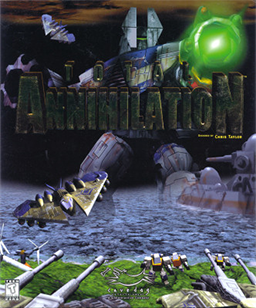
Total Annihilation is a science fiction real-time strategy video game released in September 1997 for Microsoft Windows and Mac OS by Cavedog Entertainment and distributed internationally by GT Interactive. Two expansion packs were released in 1998, The Core Contingency on April 29 and Battle Tactics on July 20, while a medieval-themed spin-off called Total Annihilation: Kingdoms was released on June 25, 1999.

Battlefield 1942 is a 2002 first-person shooter video game developed by Digital Illusions CE and published by Electronic Arts for Microsoft Windows and Mac OS X. The game can be played in single-player mode against the video game AI or in multiplayer mode against players on the Internet or in a local area network. It is a popular platform for mod developers, with many released modifications that alter the gameplay and theme.
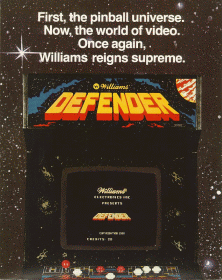
Defender is a horizontally scrolling shooter developed by Williams Electronics in 1980 and released as an arcade video game in 1981. The game is set on either an unnamed planet or city where the player must defeat waves of invading aliens while protecting astronauts. Development was led by Eugene Jarvis, a pinball programmer at Williams; Defender was Jarvis's first video game project and drew inspiration from Space Invaders and Asteroids. Defender was demonstrated in late 1980 and was released in March 1981. It was distributed in Japan by Taito.

Shooter video games or shooters are a subgenre of action video games where the focus is on the defeat of the character's enemies using ranged weapons given to the player. Usually these weapons are firearms or some other long-range weapons, and can be used in combination with other tools such as grenades for indirect offense, armor for additional defense, or accessories such as telescopic sights to modify the behavior of the weapons. A common resource found in many shooter games is ammunition, armor or health, or upgrades which augment the player character's weapons.

Xevious is a vertically scrolling shooter arcade video game developed and published by Namco in 1982. It was released in Japan by Namco and in North America by Atari, Inc. Controlling the Solvalou starship, the player attacks Xevious forces before they destroy all of mankind. The Solvalou has two weapons at its disposal: a zapper to destroy flying craft, and a blaster to bomb ground installations and enemies. It runs on the Namco Galaga arcade system.

Battlefield 2 is a first-person shooter video game developed by Digital Illusions CE and published by Electronic Arts for Microsoft Windows. It was released in June 2005 as the third game in the Battlefield franchise.
Tactical role-playing games, also known as strategy role-playing games and in Japan as simulation RPGs, are a video game genre that combines core elements of role-playing video games with those of tactical strategy video games. The formats of tactical RPGs are much like traditional tabletop role-playing games and strategy games in appearance, pacing, and rule structure. Likewise, early tabletop role-playing games are descended from skirmish wargames such as Chainmail, which were primarily concerned with combat.

Terminator 3: War of the Machines is a 2003 first-person shooter video game based on the film Terminator 3: Rise of the Machines. It was developed by Hungarian developer Clever's Games and published by Atari for Microsoft Windows. The game is set in a post-apocalyptic future when human and machine forces are battling for the world, and the player chooses which side to join. The game was negatively received, particularly for its character animations and artificial intelligence. Critics also viewed the game as a poor imitation of Battlefield 1942.
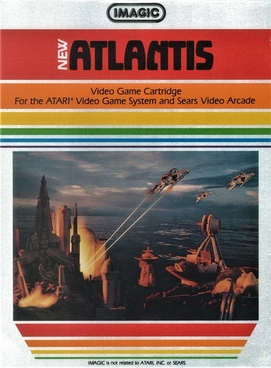
Atlantis is a fixed shooter video game released by Imagic in August 1982 for the Atari 2600. IThe game is set in the fabled city of Atlantis where the cities are under attack by invading Gorgon vessels who plan to destroy the city. The player controls sentries to fire a counter attack.
Real-time tactics (RTT) is a subgenre of tactical wargames played in real-time, simulating the considerations and circumstances of operational warfare and military tactics. It is differentiated from real-time strategy gameplay by the absence of classic resource micromanagement and base or unit building, and by the greater importance of individual units and a focus on complex battlefield tactics.
Tower defense (TD) is a subgenre of strategy games where the goal is to defend a player's territories or possessions by obstructing the enemy attackers or by stopping enemies from reaching the exits, usually achieved by placing defensive structures on or along their path of attack. This typically means building a variety of different structures that serve to automatically block, impede, attack or destroy enemies. Tower defense is seen as a subgenre of real-time strategy video games, due to its real-time origins, even though many modern tower defense games include aspects of turn-based strategy. Strategic choice and positioning of defensive elements is an essential strategy of the genre.
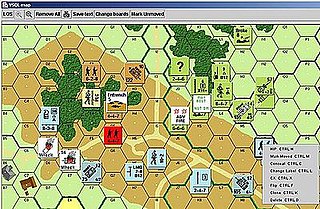
A computer wargame is a wargame played on a digital device. Descended from board wargaming, it simulates military conflict at the tactical, operational or strategic level. Computer wargames are both sold commercially for recreational use and, in some cases, used for military purposes.
Multiplayer online battle arena (MOBA) is a subgenre of strategy video games in which two teams of players compete against each other on a predefined battlefield. Each player controls a single character with a set of distinctive abilities that improve over the course of a game and which contribute to the team's overall strategy. The typical objective is for each team to destroy their opponents' main structure, located at the opposite corner of the battlefield. In some MOBA games, the objective can be defeating every player on the enemy team. Players are assisted by computer-controlled units that periodically spawn in groups and march forward along set paths toward their enemy's base, which is heavily guarded by defensive structures. This type of multiplayer online video games originated as a subgenre of real-time strategy, though MOBA players usually do not construct buildings or units. The genre is seen as a fusion of real-time strategy, role-playing and action games.

Combat Mission is the name of a series of computer wargames simulating tactical battles. The series has progressed through two distinct game engines. The original game engine, referred to as 'CMx1' by the developer, Battlefront.com, powered a trio of games set in the Second World War. Combat Mission: Shock Force was released in July 2007 as the debut of the 'CMx2' game engine. The Combat Mission games are a mixture of turn-based gameplay and simultaneous real-time execution. The game environment is fully three-dimensional, with a "Wego" style of play wherein each player enters their orders into the computer simultaneously during pauses in the action, and then are powerless to intervene during the action phase. More familiar turn-based games use an "I-go/You-go" system of play.
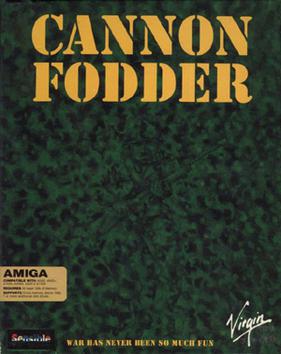
Cannon Fodder is a shoot 'em up developed by Sensible Software and published by Virgin Interactive Entertainment for the Amiga in 1993. Virgin ported the game to MS-DOS, the Atari ST and the Acorn Archimedes, as well as the Atari Jaguar, Mega Drive, SNES and 3DO. The game is military-themed and based on shooting action with squad-based tactics. The player directs troops through numerous missions, battling enemy infantry, vehicles and installations.
References
- ↑ "Atari targets Enemy in Sight - PC News at GameSpot". Archived from the original on 29 September 2007. Retrieved 9 January 2007.
- ↑ "Enemy in Sight: Headquarters -- Strategy Informer". 27 May 2006. Archived from the original on 27 May 2006. Retrieved 30 October 2024.